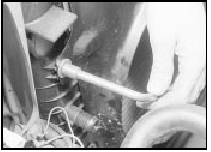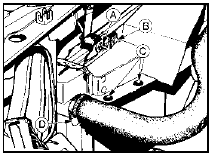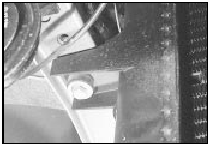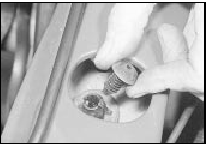Radiator - removal and refitting
Removal
1 Disconnect the battery negative lead.
2 Drain the cooling system.
3 If not already done, disconnect the bottom hose from the radiator.
4 Disconnect the top hose and the expansion tank hose from the radiator.
5 On automatic transmission models, place a suitable container beneath the fluid cooler pipe connections at the radiator. Unscrew the union and plug the upper pipe, then repeat the procedure on the lower pipe.
6 Apply the handbrake, jack up the front of the vehicle and support on axle stands (see “Jacking and Vehicle Support”).
7 To improve access, remove the cooling fan shroud as follows, according to model.
8 On SOHC models, remove the four retaining clips and unscrew the two retaining screws, then withdraw the upper section of the fan shroud. Unclip and remove the lower section of the shroud.
9 On CVH and DOHC models, unclip the wiring connector from the fan motor(s) then unscrew the retaining nuts and washers, and withdraw the fan shroud(s) and cooling fan assembly(s) (see illustration).

5.9 Unscrew the fan shroud/radiator retaining nuts
10 On early models, unscrew and remove the upper radiator mounting nuts and washers (see illustration).

5.10a Radiator and cooling fan shroud upper mountings
A Radiator mounting nut
B Shroud securing screw
C Shroud securing clips
D Radiator top hose clip
Unscrew and remove the lower mounting bolts and washers and withdraw the radiator from under the vehicle (see illustration).

5.10b Lower radiator mounting bolt
11 On all later models, the radiator is secured to the engine compartment front panel using clips and locking pegs. To release the top of the radiator, work through the cut-outs in the engine compartment front panel and remove the two radiator upper locking pegs (see illustration).

5.11Removing a radiator upper locking peg
Working under the front of the vehicle, remove the two radiator lower mounting bolts. Support the radiator from underneath. Squeeze the upper radiator locking pegs to release them from the engine compartment front panel and lower the radiator assembly from the vehicle.
Refitting
12 Refitting is a reversal of removal, bearing
in mind the following points.
13 Refill the cooling system.
14 On automatic transmission models, check and if necessary top-up the transmission fluid level.
Radiator - inspection and cleaning
1 If the radiator has been removed because of suspected blockage, reverse-flush it.
2 Clean dirt and debris from the radiator fins using an air jet or water and a soft brush. Be careful not to damage the fins or cut your fingers.
3 A radiator specialist can perform a “flow test” on the radiator to establish whether an internal blockage exists.
4 A leaking radiator must be referred to a specialist for permanent repair. Do not attempt to weld or solder a leaking radiator, as damage to the plastic parts may result.
5 In an emergency, minor leaks from the radiator can be cured by using a sealant.
See also:
Boot lid (Saloon models) - removal and refitting
Removal
1 Open the boot lid, and place protective
covers (old rags or cardboard) beneath the
corners of the lid, and over the rear wings to
prevent damage to the paintwork.
2 Where applicable, di ...
Ignition system - testing
Note: Refer to the precautions given in
Section 1 before proceeding.
Contact breaker ignition system
1 By far the majority of breakdown and
running troubles are caused by faults in the
ignition s ...
Front seat air cushion assembly - removal and refitting
Complete assembly - removal and
refitting
1 Remove the seat.
2 Straighten the seat back cover retaining
tangs, and pull the cover upwards to expose
the air cushion.
3 Cut through the four securi ...
